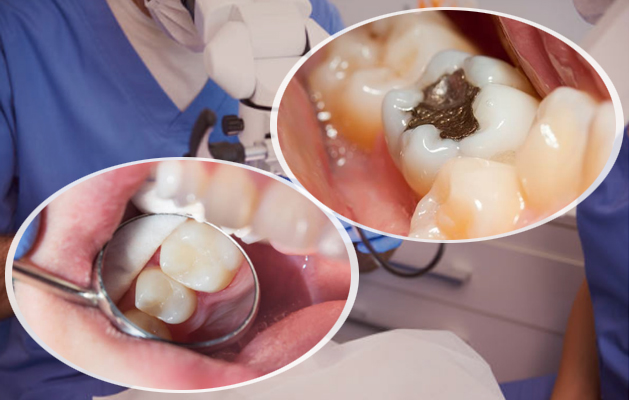All You Need to Know About Tooth Cavity Fillings
From treatment steps to types of materials available, here’s the low-down on restorative dental fillings.
As tooth decay continues to be the most common disease worldwide, it’s a fact that essentially every person at some point in their life has, or will, experience some degree of tooth decay.
But with that being said, we’re lucky in this day and age to have such a successful means of treatment available to us through dentistry: dental fillings (that is, in cases where tooth decay is not so extensive as to require a root canal).
We’re willing to guarantee that you or someone you know has at least one tooth filling currently present in the mouth (at least!) So, it’s beneficial to be in-the-know about these extremely common dental restorations.
Keep reading if you’d like to get a better understanding of what may currently be keeping your once-weakened natural teeth, or tooth, strong and secure - or if you’re simply interested in exploring the different types of fillings for future consideration.
First off: What are the steps involved during a cavity filling procedure?
During a typical cavity filling procedure, the dentist will begin by applying a local anesthetic to numb the treatment area from pain. Next, depending on the dentist’s preferences and the extent and location of decay, either a drill, air abrasion instrument or laser will be employed to remove the decayed tooth structure.
After this, the dentist will probe the treated area to ensure that all of the decay has been effectively removed. Once every trace of decay has been eliminated, the dentist will prepare the space for placement of the filling through thoroughly cleaning away any bacteria or debris.
For tooth color fillings, the most popular choice of filling material today, the dentist will apply the composite resin material in layers. After each layer is applied, a special curing light is used to harden the material and ensure it’s secured to the tooth. After this, the dentist will perform any final necessary steps such as trimming away any excess material and polishing the complete restoration.
Exploring the types of filling materials available
There are several types of tooth filling materials used by dentists today - including tooth coloured (composite resin) material, mercury silver amalgam, cast gold and porcelain. The location of the decay, degree of decay present, cost of material and your dentist’s recommendation will all play a role in determining the type of filling that’s best for your restoration.
Below, let’s take a look at both the unique advantages and the less-ideal characteristics of each of the types of fillings:
Tooth-coloured (composite) fillings:
The advantages of tooth-coloured fillings include the fact that they are just that: tooth-coloured, and can be made to closely match the shade of the treated tooth for a seamless and virtually undetectable result. Additionally, this composite material micro-mechanically bonds to tooth structure, offering the ultimate support, and even oftentimes requires less tooth structure to be removed during preparation compared to amalgam fillings. Composite resins are also very durable, and quite versatile in their ability to restore more than just decayed teeth - they can restore problems such as broken, chipped and worn teeth, as well.
Some disadvantages of tooth coloured fillings include the fact that they don’t generally last as long as amalgam fillings, particularly if used to restore large areas of decay, although there are many cases today where they do last just as long. These fillings also may take up to 20 minutes longer to place compared with amalgam fillings, and are more costly.
Silver (amalgam) fillings:
The advantages of silver amalgam fillings include their ability to last at least 10 to 15 years before requiring re-treatment, and their incomparable strength and durability. As mentioned above, this filling material is also generally less costly when compared to composite fillings.
Some disadvantages of silver amalgam fillings include the fact that they don’t blend with the natural shade of the teeth and are considered by many to be rather unsightly - and can even lead to the appearance of a greyish hue on the surrounding natural tooth structure. Furthermore, these fillings require more tooth structure (including healthy parts of the tooth beyond the decay) to be removed in order to adequately prepare the material for a secure placement, which can ultimately lead to heightened tooth sensitivity. Additionally, amalgam material may experience a greater degree of expansion and contraction with the introduction of extreme temperatures in the mouth, as it is more sensitive to hot and/or cold foods or liquids. This unfortunately results in a higher incidence of fractures and cracks.
Another issue certainly worth noting is that a very small percentage of people (roughly 1%) are allergic to the mercury that occurs in amalgam restorations. In these cases, other filling materials absolutely must be used in place of amalgam.
Cast gold fillings:
The advantages of cast gold fillings are similar to that of silver amalgam fillings, as they have the ability to last 10 to 15 years and even usually longer than this. This material is also extremely durable and resistant to corrosion, and some patients find the gold colour to be much easier on the eyes than silver amalgam fillings.
Some disadvantages of cast gold fillings include their cost, as they can be up to 10 times pricier than silver amalgam fillings. Furthermore, additional office visits are required with this filling type, as at least two office visits are needed for placement. Lastly, most patients will still prefer a filling that is virtually undetectable in the mouth, and gold is sure to stand out.
Other types of tooth filling materials
Other alternative dental filling materials include ceramics, which are most often composed of porcelain. These restorations are more resistant to staining compared to tooth-coloured composite resin, are around the same price as gold fillings, and will typically last over 15 years - making it a highly advantageous filing type.
On the other hand, glass ionomer fillings composed of acrylic and a specific type of glass material are commonly used for restorations that are below the gum line, and for young children due to its fluoride-releasing protective properties. While the cost of these filings are comparable to that of tooth-coloured fillings, some glass ionomer restorations last for only 5 years or less - but fortunately, newer ones have a much greater lifespan.
When it comes to your dental care needs (fillings included), our Dr. Maureen Fenn is here to help.
Whatever your age or oral health background, Danforth Dental Care offers a wide range of services to help you maintain your healthiest and most attractive smile.
Don’t hesitate to reach out to us today to book your next visit!


We are conveniently located near Greektown on the TTC Danforth Avenue subway line between Greenwood Avenue and Coxwell Avenue.
1411 Danforth Avenue, Toronto, ON M4J 1N2